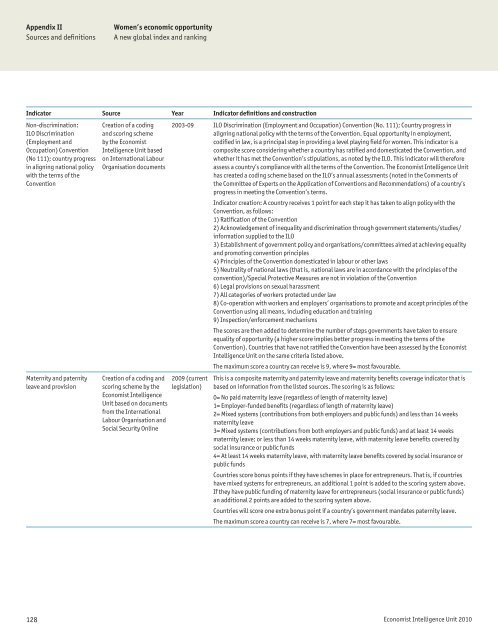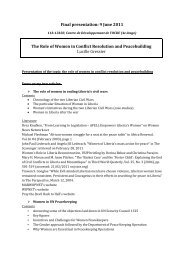Women's Economic Opportunity Index - Economist Intelligence Unit
Women's Economic Opportunity Index - Economist Intelligence Unit
Women's Economic Opportunity Index - Economist Intelligence Unit
- No tags were found...
You also want an ePaper? Increase the reach of your titles
YUMPU automatically turns print PDFs into web optimized ePapers that Google loves.
Appendix IISources and definitionsWomen’s economic opportunityA new global index and rankingIndicator Source Year Indicator definitions and constructionNon-discrimination:ILO Discrimination(Employment andOccupation) Convention(No 111); country progressin aligning national policywith the terms of theConventionMaternity and paternityleave and provisionCreation of a codingand scoring schemeby the <strong>Economist</strong><strong>Intelligence</strong> <strong>Unit</strong> basedon International LabourOrganisation documentsCreation of a coding andscoring scheme by the<strong>Economist</strong> <strong>Intelligence</strong><strong>Unit</strong> based on documentsfrom the InternationalLabour Organisation andSocial Security Online2003-09 ILO Discrimination (Employment and Occupation) Convention (No. 111); Country progress inaligning national policy with the terms of the Convention. Equal opportunity in employment,codified in law, is a principal step in providing a level playing field for women. This indicator is acomposite score considering whether a country has ratified and domesticated the Convention, andwhether it has met the Convention’s stipulations, as noted by the ILO. This indicator will thereforeassess a country’s compliance with all the terms of the Convention. The <strong>Economist</strong> <strong>Intelligence</strong> <strong>Unit</strong>has created a coding scheme based on the ILO’s annual assessments (noted in the Comments ofthe Committee of Experts on the Application of Conventions and Recommendations) of a country’sprogress in meeting the Convention’s terms.Indicator creation: A country receives 1 point for each step it has taken to align policy with theConvention, as follows:1) Ratification of the Convention2) Acknowledgement of inequality and discrimination through government statements/studies/information supplied to the ILO3) Establishment of government policy and organisations/committees aimed at achieving equalityand promoting convention principles4) Principles of the Convention domesticated in labour or other laws5) Neutrality of national laws (that is, national laws are in accordance with the principles of theconvention)/Special Protective Measures are not in violation of the Convention6) Legal provisions on sexual harassment7) All categories of workers protected under law8) Co-operation with workers and employers’ organisations to promote and accept principles of theConvention using all means, including education and training9) Inspection/enforcement mechanismsThe scores are then added to determine the number of steps governments have taken to ensureequality of opportunity (a higher score implies better progress in meeting the terms of theConvention). Countries that have not ratified the Convention have been assessed by the <strong>Economist</strong><strong>Intelligence</strong> <strong>Unit</strong> on the same criteria listed above.The maximum score a country can receive is 9, where 9= most favourable.2009 (currentlegislation)This is a composite maternity and paternity leave and maternity benefits coverage indicator that isbased on information from the listed sources. The scoring is as follows:0= No paid maternity leave (regardless of length of maternity leave)1= Employer-funded benefits (regardless of length of maternity leave)2= Mixed systems (contributions from both employers and public funds) and less than 14 weeksmaternity leave3= Mixed systems (contributions from both employers and public funds) and at least 14 weeksmaternity leave; or less than 14 weeks maternity leave, with maternity leave benefits covered bysocial insurance or public funds4= At least 14 weeks maternity leave, with maternity leave benefits covered by social insurance orpublic fundsCountries score bonus points if they have schemes in place for entrepreneurs. That is, if countrieshave mixed systems for entrepreneurs, an additional 1 point is added to the scoring system above.If they have public funding of maternity leave for entrepreneurs (social insurance or public funds)an additional 2 points are added to the scoring system above.Countries will score one extra bonus point if a country’s government mandates paternity leave.The maximum score a country can receive is 7, where 7= most favourable.128 <strong>Economist</strong> <strong>Intelligence</strong> <strong>Unit</strong> 2010




